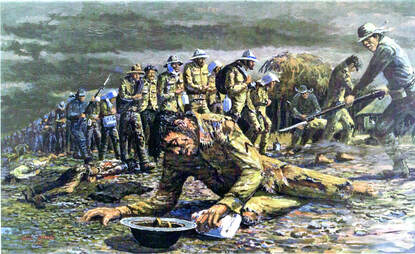|
Submitted by Dick Martin  At the beginning of WWII, the Japanese committed one of the most brutal atrocities of the entire war. It was known as, “The Bataan Death March.” The Japanese believed that it was dishonorable to surrender, and that soldiers should fight to the last man. Consequently, they treated Allied POWs with contempt and brutality. In interviewing Charles Dawes for his military biography as a German-held POW, he told me he was glad he was a German-held POW and not a Japanese-held POW. It seemed that the entire Japanese Army was capable of terrorist acts; whereas most of the German terrorists’ acts came from the SS. If you have seen the movies “The Unbroken” and the rescue of the Japanese held POWs at Cabanatuan, you will get an idea of the cruelty Japanese were capable of. Mr. Dawes told me that at his POW camp, if he did not eat, neither did the guards. Many other American soldiers, who I interviewed that fought in Europe, told me they thought that your normal German soldier was no different than the normal Allied soldier. Of course, there were exceptions to all of the above. On December 7, 1941, the Japanese attacked the 7th fleet anchored at Pearl Harbor in the Hawaiian Islands. Their goal was to destroy the 7th fleet giving them unfettered freedom to roam the Western Pacific to supply their war machine with oil from the West indies and elsewhere. On December 8, 1941, even though he knew of the attack on Pearl Harbor the day before, General Douglas MacArthur, who was the commanding officer of all forces in the Philippine Islands (PIs) got caught by the Japanese with all of his planes on the ground, which were mostly subsequently destroyed. MacArthur thought he was a God and probably had no idea of the Japanese strength. That is just a wild guess, as I have never read anywhere of his costly rookie blunder. I have no idea how he kept his command and was rescued from the PI in a daring night PT boat escape. Much to MacArthur’s surprise, 200,000 Jap soldiers swarmed onto the PI. To save Manila from a destructive house-to-house fight, MacArthur declared Manila an open city and retreated south on the Bataan Peninsula. After a fierce fight with the Japanese on the Bataan Peninsula, MacArthur’s forces (made up of US soldiers and Filipino recruits) retreated to a small island, Corregidor, off the tip of the Bataan Peninsula. Here, General MacArthur, and his troops held off relentless attacks by the Japs. However, eventually the end was close and just before the Japs overran Corregidor; MacArthur was whisked away by a PT boat (See Grover Delong’s biography). The only reason I have ever read for this action was that he was thought to be indispensable to the war effort. I don’t believe that. Due to casualties, tropical disease and constant enemy pressure, the remaining 70,000 US and Filipino troops were in desperate straits and were forced to surrender. The Japanese were not prepared to handle 70,000 surrendering troops; so they started them on a 70 mile forced march from Mariveles to San Fernando where they were packed into railway cars for the journey to Capas where they unloaded and force-marched for the last leg of the journey to Camp O’Donnell. Already weary and hungry when the march began, many fell by the wayside and were bayoneted or otherwise put to death by the Jap guards. At the end of the march, others were jammed into the holds of ships that were torpedoed by US gun boats that had no idea that the prisoners were on board. The conditions the American and Filipino soldiers endured were some of the worst recorded in WWII. Seven thousand POWs perished on the march to Camp O’Donnell and only half survived the wretched conditions there until the end of the war. My dad fought the Japanese up front and personal on the islands of Luzon and Panay. I never heard him, or anyone else who fought the Japanese, say anything bad about the Japanese. The atrocities they committed were real and worthy of condemnation. Dick Martin
0 Comments
Leave a Reply. |
Categories
All
Archives
October 2023
|